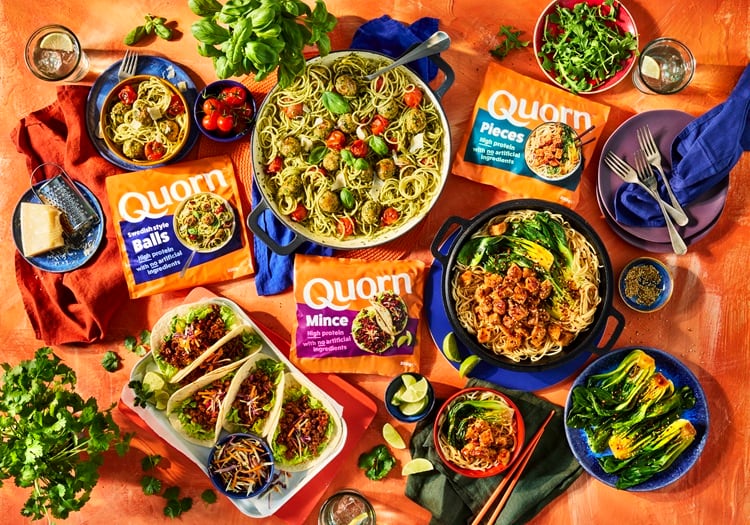Mycoprotein is facing a rough patch. One of the category’s biggest names, Quorn, is struggling with sales. Another in the US, Meati Foods, is laying off staff, while Swedish supplier Mycorena recently filed for bankruptcy.
At the same time, consumer awareness remains low. Few people globally have even heard of mycoprotein – and brands aren’t doing much to change that. When they do try, they get it wrong: Meati faced a legal challenge after marketing its products as made from “mushroom root”. In reality, they’re made from a type of red mould commonly found on bread.
Yet the promise of mycoprotein is compelling: a savoury, meat-like taste, high protein content, minimal processing and extraordinary sustainability credentials. So what’s holding it back? Is this an image problem? Or is mycoprotein simply too unfamiliar for consumers to embrace?
Mycoprotein wasn’t always struggling
The mycoprotein sector wasn’t always hard up. For decades, it was both smaller and more successful.
Marlow Foods first launched its Quorn brand in 1985. Entering the market more than 10 years ahead of the EU’s novel foods laws, the company’s Fusarium venenatum mycoprotein strain was allowed to freely enter the market without going through the arduous novel food risk assessment first.
As recently as 2021, Marlow Foods was still profitable – but its financial results have declined each year since. In 2024 alone, revenue had fallen by £186.7m (€211.5m).

While Quorn has dominated the mycoprotein space for decades, the rise of meat alternatives saw more mycoprotein makers enter the market. Meati was one, Mycorena another.
And although Meati is now hitting roadblocks and Mycorena filed for bankruptcy, new mycoprotein companies continue to enter the market. One of the most recent, Smaqo, has risen out of Mycorena’s ashes, with the same founder now blending mycoprotein with traditional meat for wider consumer acceptance.
What went wrong? Is mycoprotein just too weird to win with consumers?
Mycoprotein might seem unusual. When consumers think of alternative proteins, pea and soy are the familiar choices. By contrast, mycoprotein comes from microscopic fungi filaments fed with nutrients and fermented in large tanks – a process that doesn’t exactly sound appetising.
But it wasn’t an image problem that pushed Mycorena into bankruptcy, says founder Ram Nair. Rather, there were two unrelated factors at play: the first was that its B2B business model had a longer go-to-market lead time than expected, with many businesses not quite ready to make the switch to mycoprotein.
The other was the market downturn for plant-based meat, which Nair admits affected funding traction. “Especially at the stage when we needed larger, institutional-level investments. It was extremely difficult to raise capital for making large capex investments, but with longer ROI.”
Quorn is also unconvinced an image problem is at play. Not all shoppers are engaged with mycoprotein, admits the business’ marketing director Lucy Grogut, but she believes the protein has a “huge opportunity” to attract new shoppers.
Building appetite for mycoprotein with...meat
Mycoprotein has so much going for it. It’s healthy, sustainable, and for meat-free alternatives, surprisingly, well, meaty.
The many benefits of mycoprotein
- Mycoprotein is healthy: it's a complete protein, rich in fibre, low in saturated fat and cholesterol-free
- Mycoprotein is sustainable: production requires little land and water, and overall it boasts a low carbon footprint with minimal waste
- And mycoprotein is tasty: the filamentous structure of fungi gives mycoprotein a fibrous, chewy texture that mimics meat surprisingly well
So how can mycoprotein be framed in a way that shoppers understand, are willing to try, and return for that all-important repeat purchase?
One approach is to build familiarity and relatability with consumers. That’s the approach Nair’s Smaqo is taking. “To make mycoprotein more approachable, we’re positioning Smaqo as a hybrid brand – combining mycoprotein with traditional meat."
The founder hopes this approach will help bridge the gap between the familiar and the new. And importantly, it’s not asking too much from the consumer, who doesn’t have to give up on meat completely and make a “drastic” change in their food habits.
It’s a slow and steady strategy, he explains. “We believe that over time Smaqo will build brand trust and shift consumer perceptions, helping to position mycoprotein as a mainstream, accessible ingredient rather than a niche alternative, which is how it is perceived today.”
Is education the secret sauce of success?
Others are seeking to educate. To a certain extent, that’s Quorn’s approach with its latest ‘Nothing to Hide’ advertising campaign. No, the business isn’t educating consumers about what mycoprotein is, rather about what it isn’t.
The campaign focuses on Quorn’s frozen mycoprotein products, which it highlights contain ‘no artificial ingredients’. “People are paying closer attention to labels and ingredients and they want simple, clear nutritional cues like high in protein and fibre and low in saturated fat,” says marketing lead Grogut.
But it could be that in further promoting Quorn, the wider mycoprotein sector suffers. The main barrier to mycoprotein success is that consumers think it’s made by just one brand, says Smaqo’s Nair. “For many reasons, the average consumer still associates fungi or mycoprotein primarily with Quorn.
“After years of activity, by mostly B2B companies in the space – including my previous company Mycorena – market adoption of mycoprotein as a standalone ingredient remains limited."

That’s the education piece that’s missing, believes Nair. It’s not about how mycoprotein is made, but consumer understanding that mycoprotein does not equate to a single ingredient. “Rather, it’s a versatile ingredient that can be produced from multiple fungi strains and used across a variety of brands and product types.”
If you want consumers to trial, they need to know more
There’s another argument, a research-backed one, that consumers need more all-rounded education about mycoprotein.
According to a survey conducted by Lumina Intelligence on behalf of FoodNavigator, the ingredient’s largest challenge is awareness. Globally, two-fifths of consumers have never heard of mycoprotein.
In some regions, mycoprotein is better known than in others. Highest intention to consume mycoprotein is in China, where the vast majority of consumers have heard of it, followed by Malaysia and India. Conversely, the greatest resistance is in Europe.
So what’s the takeaway? Brands need to step up consumer education on mycoprotein. The data is clear: 40% of consumers say they wouldn’t try it simply because they don’t know enough about it.
No major player has fully embraced this strategy yet, so there’s no proof it works – but equally, there’s no evidence it doesn’t. What we do know is that the category is struggling, and doing more of the same won’t change that.
If consumers say better information would make them more willing to try, isn’t it time to listen?




